The semantic structure of word and its analysis


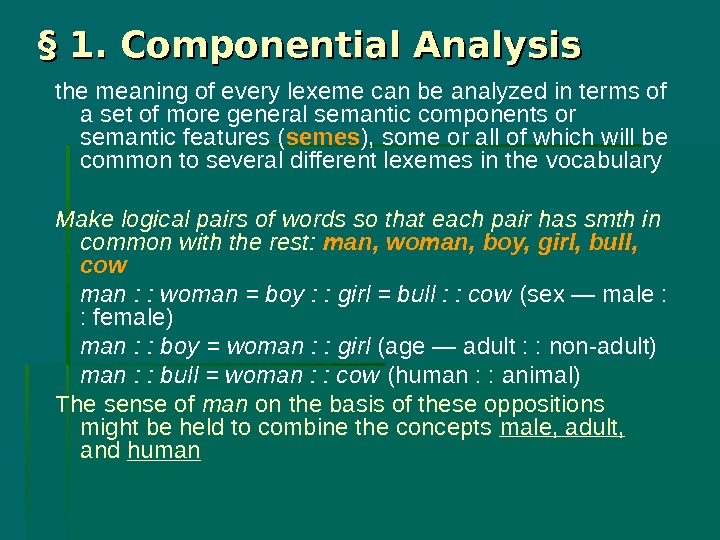


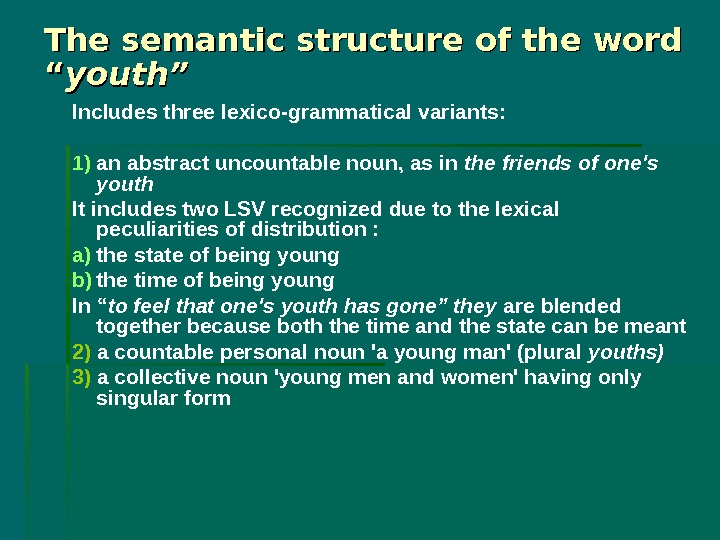



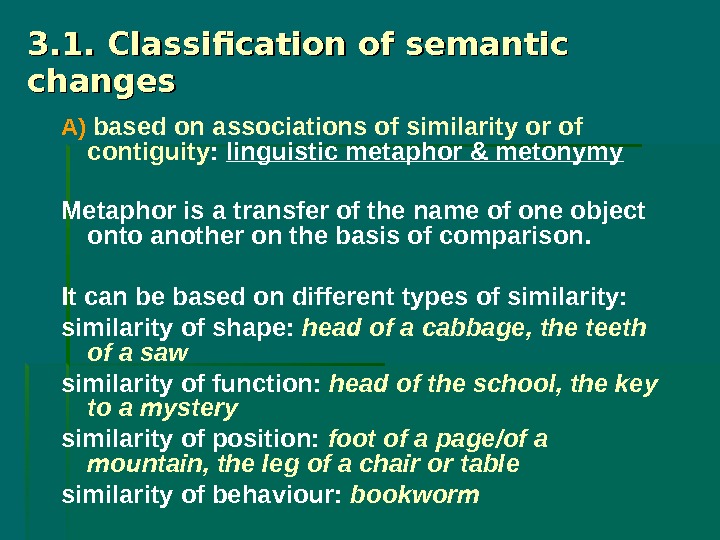

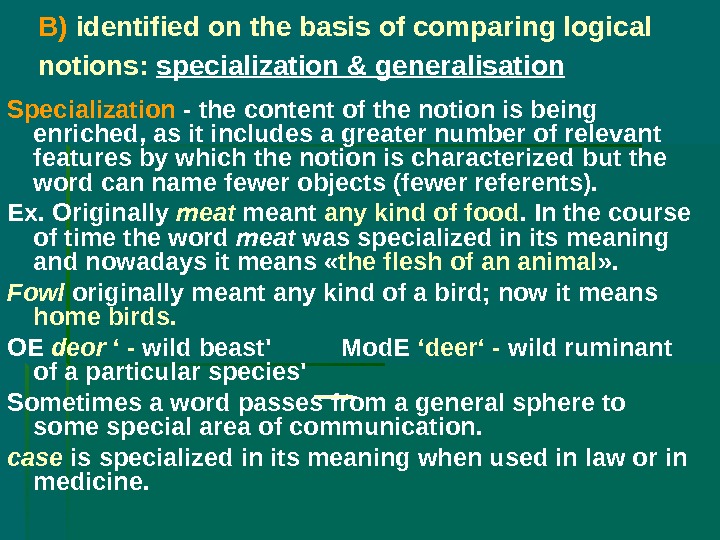




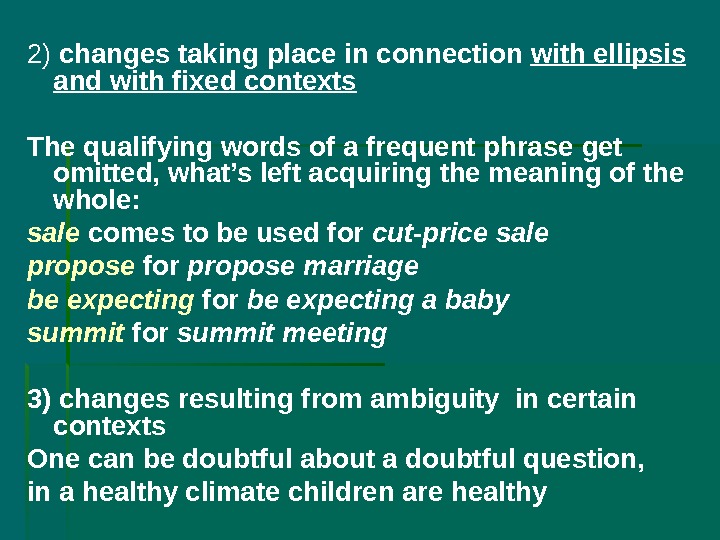


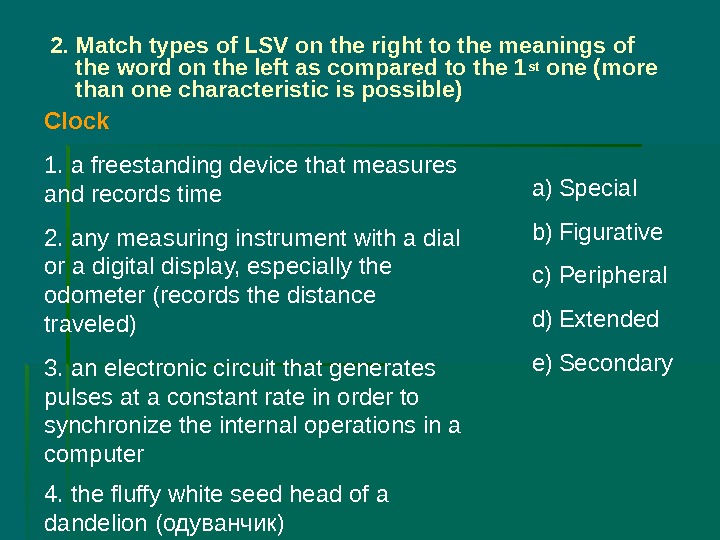


lecture_4._the_semantic_structure_of_word.ppt
- Размер: 241.5 Кб
- Количество слайдов: 21
Описание презентации The semantic structure of word and its analysis по слайдам
 The semantic structure of word and its analysis Lecture
The semantic structure of word and its analysis Lecture
 § 1. Componential Analysis the meaning of every lexeme can be analyzed in terms of a set of more general semantic components or semantic features ( semes ), some or all of which will be common to several different lexemes in the vocabulary Make logical pairs of words so that each pair has smth in common with the rest: man, woman, boy, girl, bull, cow man : : woman = boy : : girl = bull : : cow (sex — male : : female) man : : boy = woman : : girl (age — adult : : non-adult) man : : bull = woman : : cow (human : : animal) The sense of man on the basis of these oppositions might be held to combine the concepts male, adult, and human
§ 1. Componential Analysis the meaning of every lexeme can be analyzed in terms of a set of more general semantic components or semantic features ( semes ), some or all of which will be common to several different lexemes in the vocabulary Make logical pairs of words so that each pair has smth in common with the rest: man, woman, boy, girl, bull, cow man : : woman = boy : : girl = bull : : cow (sex — male : : female) man : : boy = woman : : girl (age — adult : : non-adult) man : : bull = woman : : cow (human : : animal) The sense of man on the basis of these oppositions might be held to combine the concepts male, adult, and human
 Thus, meaning may be regarded as semantic oppositions because the word’s meaning is reduced to its contrastive elements. The segmentation is continued as far as we can have markers needed for a group of words , and stops when a unique feature is reached (like classification of species in biology). A spinster — noun, count noun, human, adult, female, who has never married
Thus, meaning may be regarded as semantic oppositions because the word’s meaning is reduced to its contrastive elements. The segmentation is continued as far as we can have markers needed for a group of words , and stops when a unique feature is reached (like classification of species in biology). A spinster — noun, count noun, human, adult, female, who has never married
 § 2. Polysemy and Semantic structure of the word The word is a structured set of interrelated lexical variants realized in different contexts and thought of as a group because manifested with one form and have a common semantic component. Polysemy is the ability of a word to possess several meanings (or lexico-semantic variants — LSV ). All lexico-semantic variants of a word taken together form its semantic structure or semantic paradigm. Some LSV are lexico-grammatical variants of a word, i. e. they belong to different lexico-grammatical groups of the same part of speech. Ex. run is intransitive in / ran home, but transitive in / run this office. Some of the variants demand an object naming some vehicle as in to run a car off the road ( go or take off course ), and so on.
§ 2. Polysemy and Semantic structure of the word The word is a structured set of interrelated lexical variants realized in different contexts and thought of as a group because manifested with one form and have a common semantic component. Polysemy is the ability of a word to possess several meanings (or lexico-semantic variants — LSV ). All lexico-semantic variants of a word taken together form its semantic structure or semantic paradigm. Some LSV are lexico-grammatical variants of a word, i. e. they belong to different lexico-grammatical groups of the same part of speech. Ex. run is intransitive in / ran home, but transitive in / run this office. Some of the variants demand an object naming some vehicle as in to run a car off the road ( go or take off course ), and so on.
 The semantic structure of the word ““ youth” Includes three lexico-grammatical variants: 1) an abstract uncountable noun, as in the friends of one’s youth It includes two LSV recognized due to the lexical peculiarities of distribution : a) the state of being young b) the time of being young In “ to feel that one’s youth has gone” they are blended together because both the time and the state can be meant 2) a countable personal noun ‘a young man’ (plural youths) 3) a collective noun ‘young men and women’ having only singular form
The semantic structure of the word ““ youth” Includes three lexico-grammatical variants: 1) an abstract uncountable noun, as in the friends of one’s youth It includes two LSV recognized due to the lexical peculiarities of distribution : a) the state of being young b) the time of being young In “ to feel that one’s youth has gone” they are blended together because both the time and the state can be meant 2) a countable personal noun ‘a young man’ (plural youths) 3) a collective noun ‘young men and women’ having only singular form
 Types of LSV as elements of a word’s semantic structure 1. Direct (nominates the referent in isolation, i. e. in one word sentences ex. fire-screen ) vs. figurative (the object named is characterized through its similarity with another object ex. smoke screen ) 2. Concrete vs. abstract ( screen actor, screen version ) 3. main/primary (the highest frequency) vs. secondary 4. Central vs. peripheral ( derived; ex. screen as ‘a silver-colored sheet on which pictures are shown ‘) 5. Narrow vs. extended (due to the scope of corresponding concept) 6. General vs. special/particular (terminological) 7. present-day vs. obsolete 8. stylistically neutral vs. stylistically coloured
Types of LSV as elements of a word’s semantic structure 1. Direct (nominates the referent in isolation, i. e. in one word sentences ex. fire-screen ) vs. figurative (the object named is characterized through its similarity with another object ex. smoke screen ) 2. Concrete vs. abstract ( screen actor, screen version ) 3. main/primary (the highest frequency) vs. secondary 4. Central vs. peripheral ( derived; ex. screen as ‘a silver-colored sheet on which pictures are shown ‘) 5. Narrow vs. extended (due to the scope of corresponding concept) 6. General vs. special/particular (terminological) 7. present-day vs. obsolete 8. stylistically neutral vs. stylistically coloured
 Contexual meaning 9. language meaning vs. speech meaning (contextual/implicational) Contextual/implicational is the communicative value of a word based on latent possibilities which are not realized in a particular LSV but able to create new derived meanings; the information implied by virtue of what the speakers know about the referent Ex. A wolf is known to be greedy and cruel but the denotative meaning of this word does not necessarily include these features ( He is a wolf = a cruel greedy person ) Ex. Some men have acted courage who had it not; but no man can act wit (=pretend + irony because of unusual LG meaning of transitivity and the lexical meaning of objects to this verb) Ex. bomb implies great power the new colloquial meanings ‘great success ‘ and ‘great failure ‘
Contexual meaning 9. language meaning vs. speech meaning (contextual/implicational) Contextual/implicational is the communicative value of a word based on latent possibilities which are not realized in a particular LSV but able to create new derived meanings; the information implied by virtue of what the speakers know about the referent Ex. A wolf is known to be greedy and cruel but the denotative meaning of this word does not necessarily include these features ( He is a wolf = a cruel greedy person ) Ex. Some men have acted courage who had it not; but no man can act wit (=pretend + irony because of unusual LG meaning of transitivity and the lexical meaning of objects to this verb) Ex. bomb implies great power the new colloquial meanings ‘great success ‘ and ‘great failure ‘
 § 3. Semantic change: ways of semantic structure development The semantic structure of a word is a flexible category, it changes with the development of the language. radiation and chain-development # 1 # 2 # 3 # 4 # 1 # 2 # 4 # 3 # 5 the split of polysemy; homonyms
§ 3. Semantic change: ways of semantic structure development The semantic structure of a word is a flexible category, it changes with the development of the language. radiation and chain-development # 1 # 2 # 3 # 4 # 1 # 2 # 4 # 3 # 5 the split of polysemy; homonyms
 3. 1. Classification of semantic changes A) based on associations of similarity or of contiguity : linguistic metaphor & metonymy Metaphor is a transfer of the name of one object onto another on the basis of comparison. It can be based on different types of similarity: similarity of shape: head of a cabbage, the teeth of a saw similarity of function: head of the school, the key to a mystery similarity of position: foot of a page/of a mountain, the leg of a chair or table similarity of behaviour: bookworm
3. 1. Classification of semantic changes A) based on associations of similarity or of contiguity : linguistic metaphor & metonymy Metaphor is a transfer of the name of one object onto another on the basis of comparison. It can be based on different types of similarity: similarity of shape: head of a cabbage, the teeth of a saw similarity of function: head of the school, the key to a mystery similarity of position: foot of a page/of a mountain, the leg of a chair or table similarity of behaviour: bookworm
 Metonymy is a transfer of the meaning on the basis of contiguity ( closeness or contact ). Wall Street is in a panic The White House isn’t saying anything the crown for ‘monarchy‘ hand for ‘handwriting‘ diesel engine — a type of compression ignition engine invented by a German mechanical engineer Rudolf Diesel I want to have a word with you (part for the whole)
Metonymy is a transfer of the meaning on the basis of contiguity ( closeness or contact ). Wall Street is in a panic The White House isn’t saying anything the crown for ‘monarchy‘ hand for ‘handwriting‘ diesel engine — a type of compression ignition engine invented by a German mechanical engineer Rudolf Diesel I want to have a word with you (part for the whole)
 B) identified on the basis of comparing logical notions: specialization & generalisation Specialization — the content of the notion is being enriched, as it includes a greater number of relevant features by which the notion is characterized but the word can name fewer objects (fewer referents). Ex. Originally meat meant any kind of food. In the course of time the word meat was specialized in its meaning and nowadays it means « the flesh of an animal » . Fowl originally meant any kind of a bird; now it means home birds. OE deor ‘ — wild beast’ Mod. E ‘deer‘ — wild ruminant of a particular species’ Sometimes a word passes from a general sphere to some special area of communication. case is specialized in its meaning when used in law or in medicine.
B) identified on the basis of comparing logical notions: specialization & generalisation Specialization — the content of the notion is being enriched, as it includes a greater number of relevant features by which the notion is characterized but the word can name fewer objects (fewer referents). Ex. Originally meat meant any kind of food. In the course of time the word meat was specialized in its meaning and nowadays it means « the flesh of an animal » . Fowl originally meant any kind of a bird; now it means home birds. OE deor ‘ — wild beast’ Mod. E ‘deer‘ — wild ruminant of a particular species’ Sometimes a word passes from a general sphere to some special area of communication. case is specialized in its meaning when used in law or in medicine.
 Generalization (reverse to specialization) is the way of transforming the meaning when a word acquires a broader meaning. Due to the change of use: to serve was a clerical term, now it is used in everyday speech To arrive was a nautical term, which meant to reach the land by water. Now it means to reach the place of destination in any way: by land, by water, by air. The transfer from a concrete meaning to an abstract one: Journey was borrowed from French with the meaning one day trip , now it means a trip of any duration. Fly originally meant ‘to move through the air with wings ‘; now it denotes any kind of movement in the air or outer space
Generalization (reverse to specialization) is the way of transforming the meaning when a word acquires a broader meaning. Due to the change of use: to serve was a clerical term, now it is used in everyday speech To arrive was a nautical term, which meant to reach the land by water. Now it means to reach the place of destination in any way: by land, by water, by air. The transfer from a concrete meaning to an abstract one: Journey was borrowed from French with the meaning one day trip , now it means a trip of any duration. Fly originally meant ‘to move through the air with wings ‘; now it denotes any kind of movement in the air or outer space
 C) Changes depending on the social attitude to the object named and change of emotional tone: amelioration & pejoration Words change semantic structure because their referents come up or down the social scale Pejoration (degradation) is the way of transforming the meaning when the meaning becomes worse: villain originally meant working on a villa. Then it acquired the meaning of scoundrel. Churl means ‘an ill-mannered and surly fellow, a boor ‘ ceorl of the 13 th century denoted the lowest rank of a freeman, later — a serf clown — the original meaning was also ‘peasant’ or ‘farmer’.
C) Changes depending on the social attitude to the object named and change of emotional tone: amelioration & pejoration Words change semantic structure because their referents come up or down the social scale Pejoration (degradation) is the way of transforming the meaning when the meaning becomes worse: villain originally meant working on a villa. Then it acquired the meaning of scoundrel. Churl means ‘an ill-mannered and surly fellow, a boor ‘ ceorl of the 13 th century denoted the lowest rank of a freeman, later — a serf clown — the original meaning was also ‘peasant’ or ‘farmer’.
 Amelioration ( elevation) is the way of transforming the meaning when it becomes better in the cause of time: knight meant a boy , then became a servant , at last it acquired a meaning о f a noble man. OE cwen ‘a woman’ Mod. E queen noble as ‘ possessing high ideals or excellent moral character ’ from ‘belonging to the nobility’
Amelioration ( elevation) is the way of transforming the meaning when it becomes better in the cause of time: knight meant a boy , then became a servant , at last it acquired a meaning о f a noble man. OE cwen ‘a woman’ Mod. E queen noble as ‘ possessing high ideals or excellent moral character ’ from ‘belonging to the nobility’
 3. 2. Causes of semantic changes A) linguistic 1) Differentiation of synonyms is a gradual change observed in the course of language history, sometimes involving the semantic assimilation of loan words Ex. time and tide used to be synonyms. Then tide took on its more limited application to the shifting waters , and time alone is used in the general sense. The word beast was borrowed from French into Middle English. Before it appeared the general word for animal was deer which after the word beast was introduced became narrowed to its present meaning ‘a hoofed animal of which the males have antlers’
3. 2. Causes of semantic changes A) linguistic 1) Differentiation of synonyms is a gradual change observed in the course of language history, sometimes involving the semantic assimilation of loan words Ex. time and tide used to be synonyms. Then tide took on its more limited application to the shifting waters , and time alone is used in the general sense. The word beast was borrowed from French into Middle English. Before it appeared the general word for animal was deer which after the word beast was introduced became narrowed to its present meaning ‘a hoofed animal of which the males have antlers’
 2) changes taking place in connection with ellipsis and with fixed contexts The qualifying words of a frequent phrase get omitted, what’s left acquiring the meaning of the whole: sale comes to be used for cut-price sale propose for propose marriage be expecting for be expecting a baby summit for summit meeting 3) changes resulting from ambiguity in certain contexts One can be doubtful about a doubtful question, in a healthy climate children are healthy
2) changes taking place in connection with ellipsis and with fixed contexts The qualifying words of a frequent phrase get omitted, what’s left acquiring the meaning of the whole: sale comes to be used for cut-price sale propose for propose marriage be expecting for be expecting a baby summit for summit meeting 3) changes resulting from ambiguity in certain contexts One can be doubtful about a doubtful question, in a healthy climate children are healthy
 B) The extralinguistic causes are determined by the social nature of the language 1) the development of the notion expressed and the thing named The word space meant ‘extent of time or distance’. Alongside this meaning a new meaning developed ‘the limitless and indefinitely great expanse in which all material objects are located’ 2) the appearance of new notions and things The word bikini as ‘a very scanty two-piece bathing suit worn by women ’, is named after Bikini atoll in the Western Pacific because it appeared at the time when the atomic bomb tests by the US in the Bikini atoll were fresh in everybody’s memory. The associative field is emotional referring to the «atomic» shock the first bikinis produced.
B) The extralinguistic causes are determined by the social nature of the language 1) the development of the notion expressed and the thing named The word space meant ‘extent of time or distance’. Alongside this meaning a new meaning developed ‘the limitless and indefinitely great expanse in which all material objects are located’ 2) the appearance of new notions and things The word bikini as ‘a very scanty two-piece bathing suit worn by women ’, is named after Bikini atoll in the Western Pacific because it appeared at the time when the atomic bomb tests by the US in the Bikini atoll were fresh in everybody’s memory. The associative field is emotional referring to the «atomic» shock the first bikinis produced.
 Practical task # 4 1. Guess whether words below are homonyms (different words accidentally having one form) or LSV of one word a) 26 letters of the ABC vs. to receive letters regularly b) To be a foot long vs. at the foot of the mountain c) A hand of the clock vs. to hold a pen in one’s hand
Practical task # 4 1. Guess whether words below are homonyms (different words accidentally having one form) or LSV of one word a) 26 letters of the ABC vs. to receive letters regularly b) To be a foot long vs. at the foot of the mountain c) A hand of the clock vs. to hold a pen in one’s hand
 2. Match types of LSV on the right to the meanings of the word on the left as compared to the 1 st one (more than one characteristic is possible) Clock 1. a freestanding device that measures and records time 2. a ny measuring instrument with a dial or a digital display, especially the odometer ( records the distance traveled ) 3. an electronic circuit that generates pulses at a constant rate in order to synchronize the internal operations in a computer 4. the fluffy white seed head of a dandelion (одуванчик) a) Special b) Figurative c) Peripheral d) Extended e) Secondary
2. Match types of LSV on the right to the meanings of the word on the left as compared to the 1 st one (more than one characteristic is possible) Clock 1. a freestanding device that measures and records time 2. a ny measuring instrument with a dial or a digital display, especially the odometer ( records the distance traveled ) 3. an electronic circuit that generates pulses at a constant rate in order to synchronize the internal operations in a computer 4. the fluffy white seed head of a dandelion (одуванчик) a) Special b) Figurative c) Peripheral d) Extended e) Secondary
 3. Define the type of semantic change in the semantic structure of the word a) “ case” from ‘circumstances in which a person or a thing is’ to ‘a patient’, ‘an illness’ (in medicine) b) “ cat” from ‘ a small domesticated mammal that has soft fur, sharp claws, pointed ears, and, usually, a long furry tail ’ to ‘ a spiteful or malicious woman ’ c) “ iron” from ‘ a heavy, magnetic, silvery white metallic element ( Symbol Fe ) to ‘ a small electrical appliance with a flat metal base that is heated and used to press clothes ’
3. Define the type of semantic change in the semantic structure of the word a) “ case” from ‘circumstances in which a person or a thing is’ to ‘a patient’, ‘an illness’ (in medicine) b) “ cat” from ‘ a small domesticated mammal that has soft fur, sharp claws, pointed ears, and, usually, a long furry tail ’ to ‘ a spiteful or malicious woman ’ c) “ iron” from ‘ a heavy, magnetic, silvery white metallic element ( Symbol Fe ) to ‘ a small electrical appliance with a flat metal base that is heated and used to press clothes ’
 Chair 1. 1. a seat with a back support, usually for one person 2. 2. somebody presiding over something such as a committee, board, or meeting 3. 3. somebody who holds an endowed professorship at a university 4. 4. the ranked position of a musician in an orchestra 5. 5. a device to keep reinforcing rods in place during the pouring of concrete
Chair 1. 1. a seat with a back support, usually for one person 2. 2. somebody presiding over something such as a committee, board, or meeting 3. 3. somebody who holds an endowed professorship at a university 4. 4. the ranked position of a musician in an orchestra 5. 5. a device to keep reinforcing rods in place during the pouring of concrete

